What Are Accent Diamonds? (And YES, They Do Matter)
Did you know that there is more to a diamond than just one stone? Or that the focal point of the centerpiece is not always the only part that matters?
Have you ever thought that it might be nice to add some more sparkle to a piece you own or would like to own? Then you should definitely be considering the use of accent diamonds in your jewelry piece.
More about these beautiful stones can be found here – read on!
Examples of Diamond Accents in Engagement Rings
Accent diamonds (or sometimes called diamond accents) are much like what you would expect. They are an accent – an added piece and in a way, an elaboration to amplify the beauty of a jewelry piece.
In a nutshell, the goal of diamond accents is to create subtle but observable differences. Feel free to click on the photographs above to see the ring settings in more details.
Diamond accents should not overwhelm the overall appearance of the jewelry piece. When correctly utilized, they add sparkle in a streamlined manner and complement the main gem perfectly.
What Are Ideal Ratios For Accent Diamonds in 3-Stone Rings?
Well, there’s really no hard science or magic formula here.
This is because relative proportions is a factor that should be determined by your own preferences. Setting design and the shape of the accent diamonds are also things that will affect your decision as well.
With that said, here is my guideline for selecting accent diamonds in a 3 stone ring. In general, I would recommend diamonds that are roughly half the carat weight of the center stone.
For example, if your center stone is a 1 carat G VS2 round diamond, you may want to consider accent diamonds around 0.5 carats in size. I would also recommend keeping color/clarity ratings within 2 grades of the center stone.
Now, I need to emphasize that this is just a guideline and not rules that are cast in stone. If you like the look of smaller or larger accent diamonds, it’s really all that matters. After all, you are the person who is going to wear that piece of jewelry.
You Get What You Pay For or Less If You Cheapen Out
In the market, most jewelers offer settings with predetermined carat sizes and quality for accent diamonds. The most common problem here is that these diamonds are seldom graded because their smaller sizes make it uneconomical to do so.
When this happens, you will have to take the word of the jeweler for the represented quality of the side stones. Sadly, this leaves a huge avenue for unethical jewelers to abuse.
From my personal experience, I can tell you that most salespeople and jewelers will simply brush off the importance of accent diamonds and actually OVERSTATE their quality.
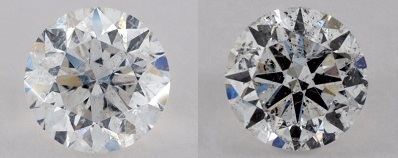
Examples of accent stones with terrible quality.
If you observe accent diamonds with your naked eye and find that they are cloudy/dull (left) or heavily included (right), it is a serious cause for concern and a huge red flag.
Buy Only GIA/AGS Graded Diamonds Above 0.3ct
If you are using larger sized accent stones above 0.30 carats for your jewelry piece, make sure you buy only GIA or AGS graded diamonds. This will ensure you get the quality that is specified.
Where to Get Accent Diamonds With The Best Cut Quality?
When it comes to cut quality and light performance, these are aspects of a diamond (no matter how big or small) that I would never compromise. I advocate that you do the same as well if you want a jewelry piece that’s lively and full of sparkle.
Brian Gavin and White Flash are 2 vendors that utilize super ideal cut accent diamonds and melees in their settings. As far as I know, no other vendor offers the same level of cut quality at competitive prices compared to them.
Here’s a perspective on the size of the melee diamonds that are typically used in ring settings.
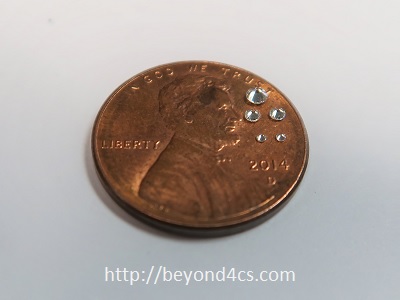
Some of the smallest melees can measure from 1 mm in diameter!
First of all, the small size of the melees make them difficult to handle; let alone to polish them to ideal proportions. Yet, vendors like Brian Gavin are able to offer ideally cut melee diamonds because of their commitment to achieving the highest quality in the jewelry they make.
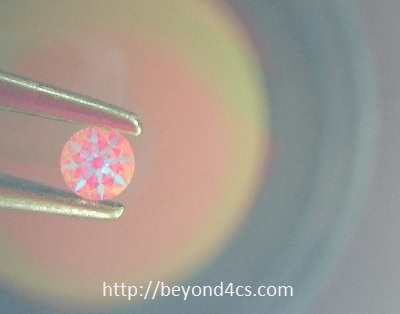
This is an ASET image I captured with difficulty due to the tiny size of the melee (handling them is really tough!). As you can see, the saturated reds indicate very strong light return. What’s even more amazing is that the contrast patterning of the melees is highly symmetrical!
Craftsmanship And Attention to Details Matter When Using Accent Stones
The skill and craftsmanship standards of a vendor make all the difference between settings that “pop” and the ones that look “meh”. Since every accent diamond is different and polished individually, details like diameter dimensions, table sizes and cut quality can vary.
In jewelry designs where the accent diamonds are supposed to look uniform, scrutiny is required at the backend processes of the jeweler’s bench.
On the other hand, when different sized accent diamonds are required in designs like tapered channels, the craftsmanship of the jeweler will make or break the final appearance.
As you can see in the example above, the finished shanks display a fluid flow of mounted melees in decreasing sizes. The shanks are cleanly made and show a high level of workmanship expertise.
The point I want to bring across here is that good bench jewelers care about the smallest of details and impose strict standards when the ring is fabricated.
The Bottomline About Accent Diamonds
Just like selecting your center diamond and ring design, the quality of accent diamonds DO matter. If you want the overall jewelry piece to have the best possible brilliance, every tiny detail will matter.
With that, I want to end off this month’s blog post by wishing our readers a Happy Mother’s Day!
Related Articles
Leave A Comment

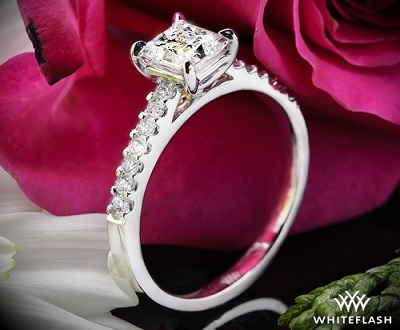
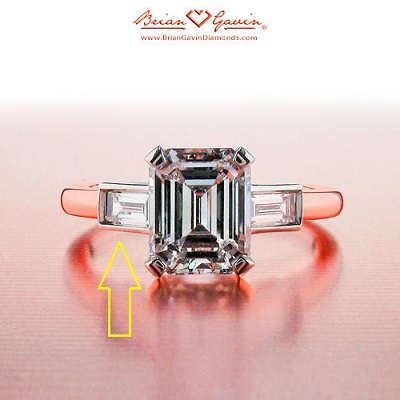
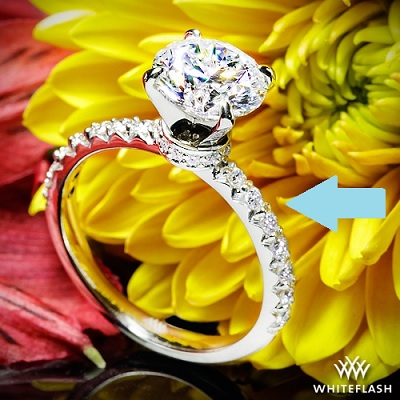

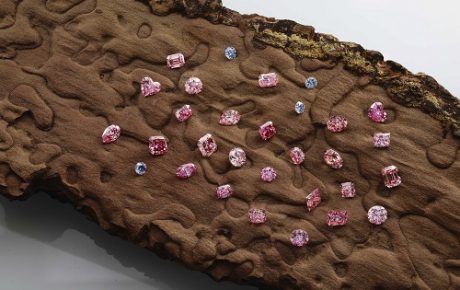
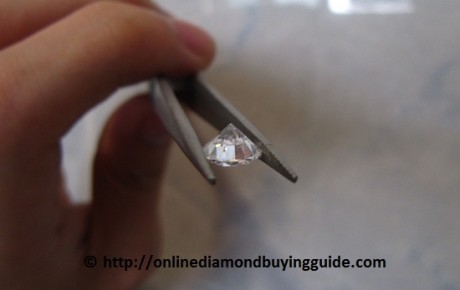











5 Comments
I came across a listing on eBay for a 14k white gold diamond accent ring. It has a round diamond flanked by 2 rectangular shaped diamonds in a vintage kind of design. The cost of this ring is $5,600.
What does diamond accent mean when they say it is 0.7 ctw and an average of J/SI2? Is diamond accent real diamond? How can I know whether the jewelry is real or fake?
First of all, you need to find out whether the diamonds have been graded by GIA or AGS. From what I can surmise, I am assuming that the meaning of diamond accent used is roughly 0.35ct per side stone. The stones are claimed to be of J color and SI2 clarity. You will need to check this definition with the seller.
Based on personal experience, this deal sounds sketchy and I’m pretty sure the quality of the stones are overstated. With regards to the accent stones being real or fake, you will need to trust what the seller claims it to be. This is precisely why I am telling readers to buy only graded diamonds. You leave second guessing out of the equation. Avoid buying on eBay completely if you don’t want to experience the trauma that I did.
What’s the correct definition and meaning of accent diamonds? My jeweller tells me they are defined as the bigger stones on the shanks used in an engagement ring. In your article, your definition of accent diamonds include the smaller melees as well. Are the pave diamonds considered under the same definition?
Also, can you recommend any places with accent diamonds for sale in the UK? I am based in London and could make my way to Hatton Gardens if you know someone reliable there.
If you are wondering what are tiny diamonds called, they are called melees.
My definition of accent diamonds is any stones that help accentuate and place emphasis on the center stone regardless of their carat size or weight. They work well across petite diamond rings and even highly elaborate designs. Basically, they help lead your eyes and attention towards the main “attraction”. So, melees can be accent stones but accent stones may not necessarily be melees if the stones used are large. I hope this explanation of the different terminologies helped to clarify things!
Now, your shopping mindset about finding accent diamonds for sale is very dangerous and will often lead to disappointments and rip off. High quality accent diamonds never go on sale or for discounts. It’s the ones with terrible quality that get slapped with a huge price point and have their prices slashed to create the illusion of getting a good deal.
Stick with the vendors that I recommend above if you care about quality and don’t want to get ripped off.
@Elvira that’s alot of money just for accent diamonds!?
@Paul Gian nice explanation but I used to think ‘accent diamonds’ means diamonds smaller than melees coz usually when diamonds get to a certain size they don’t call side stone diamonds as accent diamonds anymore.